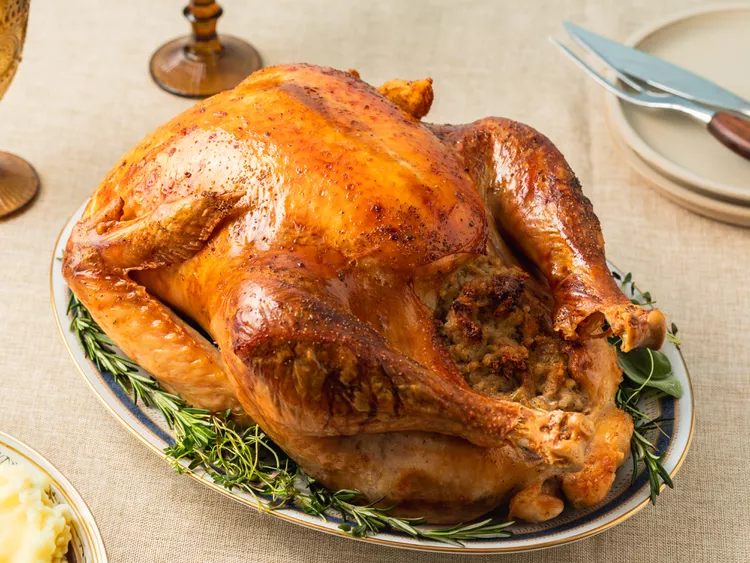The Dry Brine Secret: Your Foolproof Thanksgiving Turkey Recipe for Juicy Meat and Crispy Skin
The Thanksgiving turkey is the ultimate holiday icon, but the thought of dry, bland meat is a perennial source of stress for home cooks. Thankfully, modern culinary experts agree on one game-changing technique: the dry brine.1 This simple, low-fuss method guarantees a moist turkey with a beautifully crispy, golden-brown skin, transforming your holiday centerpiece from a challenge into a triumph.2
Forget the messy, bulky wet brine and the endless, often ineffective, basting. This guide focuses on the most effective techniques—dry brining, strategic seasoning, and precise temperature monitoring—to deliver a perfect roast every single time.
🔪 Preparation is Everything: From Thaw to Brine
A truly great turkey requires a couple of days of advance planning, primarily for safe thawing and the essential dry brine process.3
H2 Thawing Safely and Sizing Your Bird
Plan ahead to ensure your frozen bird is fully thawed well before Turkey Day.4 Slow thawing in the refrigerator is the safest method.
-
Sizing Guide: Plan for 1.5 pounds (approx. 0.7 kg) of turkey per person to ensure ample portions and leftovers.
-
Thawing Time: Allow approximately 24 hours of thawing time for every 4-5 pounds of turkey weight.5 For a 15-pound turkey, this means 3–4 days in the refrigerator.
H2 The Magic of the Dry Brine
The dry brine is simply a specialized salt rub, applied directly to the turkey.6 The salt draws moisture out of the turkey, creating a concentrated salty liquid that is then re-absorbed into the meat.7 This process seasons the turkey deep within, breaks down muscle fibers for tenderness, and critically, dries out the skin’s surface for maximum crispiness.8
The Brine Formula (Per 5 lbs of Turkey):
-
1 tablespoon Kosher Salt (Use Diamond Crystal, or 3/4 tablespoon of Morton’s Kosher Salt).9
-
Optional: 1 teaspoon dried herbs (thyme, sage, rosemary), and 1/2 teaspoon black pepper.10
-
Prep: Remove the giblets and neck.11 Do not rinse the turkey (this increases the risk of spreading bacteria).12 Pat the turkey completely dry with paper towels.13
-
Brine: Gently rub the brine mixture all over the turkey’s exterior, including inside the cavity.14 For extra flavor, work some salt under the breast skin.15
-
Rest: Place the turkey, uncovered, on a rack in a roasting pan and refrigerate for 24 to 48 hours.16 This air exposure is vital for the skin to dry out and crisp up during roasting.17
🔥 Roasting: Temperature Control and the Herb Butter Rub
On the day of the feast, a strategic approach to roasting ensures the white meat stays juicy while the dark meat cooks through.
H3 Flavor and Moisture: The Compound Butter
About an hour before roasting, remove the turkey from the refrigerator to let it come closer to room temperature.18 This promotes more even cooking.
-
Herb Butter: Mix softened unsalted butter with fresh herbs, minced garlic, and lemon zest.
-
Application: Rub the compound butter over the entire skin and gently slide a generous amount under the breast skin to keep the meat moist and infuse it with flavor.19
H3 Aromatics, Not Stuffing
To ensure your turkey cooks evenly and safely, cook the stuffing separately (often called dressing). Fill the turkey cavity loosely with aromatics: quartered yellow onion, fresh herbs (thyme and sage), halved lemons, and celery chunks. These will perfume the meat and flavor your pan drippings for gravy.20
🌡️ The Final Cook and Critical Rest
Roasting Technique and Temperature
The most crucial tool you own for this recipe is an instant-read meat thermometer.21 It is the only way to avoid overcooking.
-
Start High: Preheat your oven to 425°F (220°C).22 Roast the turkey for the first 30–45 minutes to set the skin and achieve that golden-brown color.23
-
Finish Low: Reduce the heat to 325°F (160°C) and continue roasting.24
-
Shielding: If the breast skin starts to brown too much, loosely tent it with aluminum foil to slow its cooking.25
Target Temperatures:
-
Thigh (Thickest Part, avoiding bone): 26$165^\circ\text{F}$ (27$74^\circ\text{C}$)28
-
Breast (Thickest Part): Aim for $155^\circ\text{F}$ to $160^\circ\text{F}$ ($68^\circ\text{C}$ to $71^\circ\text{C}$). The internal temperature will safely rise to $165^\circ\text{F}$ during the rest (known as carryover cooking).
The Mandatory 30-Minute Rest
Once the target temperature is reached, transfer the turkey to a carving board.29 Tent it loosely with foil and allow it to rest for 30 to 45 minutes. This period is vital, as it allows the internal juices to redistribute back into the meat, ensuring every slice is incredibly juicy and tender.
With the power of the dry brine and careful temperature monitoring, you will serve the most perfectly seasoned and cooked turkey your guests have ever tasted, making your Thanksgiving dinner truly unforgettable.
